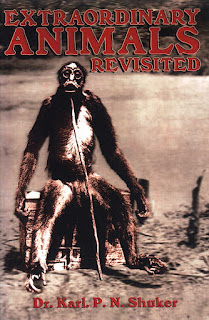Down through the decades, I have documented a wide range of canine cryptids, but two of the least-known examples are those presented here, making their ShukerNature debut. One is now a former mystery canid, the other remains an enigma.
A wild dog of once-controversial scientific status was a mysterious specimen discovered on Mount Popa, a dormant volcano in the region of Mandalay in central Burma (now Myanmar). Renowned British zoologist Reginald I. Pocock stated in 1936 that no specimens of Asia's very distinctive wild red dog or dhole Cuon alpinus had ever been obtained from Burma, but shortly afterwards he learnt that acclaimed mammalogist and animal collector Guy C. Shortridge had secured a specimen on Mount Popa.
Naturally, Pocock was anxious to examine this unique example, an adult female, especially as Shortridge alleged that it only had five pairs of teats (female dholes have 6-8 pairs), and weighed only 19 lb (unusually light for a dhole). However, after studying its skull, uncovered at the British Museum, Pocock recognized that it had been nothing more than an old, small domestic dog Canis familiaris, with a high crown and short muzzle. But, ironically, genuine Burmese dholes were obtained later, and in 1941 Pocock christened their subspecies C. a. adustus – a taxonomic classification still recognised today.
As for the yokyn – this still-unexplained canine cryptid is a strange dog-like beast reputedly well-known to Australian aboriginals and farmers. Said to be approximately half the size of a full-grown dingo, with disproportionately long claws, a stocky, muscular build, and a very variable pelage (sometimes brindled, sometimes even multi-coloured), a specimen has yet to be formally examined, so its identity remains uncertain (Fate, May 1977; also click here for additional details online).
An unknown species, an odd type of feral domestic dog, a dingo Canis dingo (aka C. lupus dingo aka C. familiaris dingo), a dog-dingo crossbreed, and even a surviving mainland race of the marsupial Tasmanian wolf Thylacinus cynocephalus are among those identities on offer. If anyone reading this ShukerNature article has further information concerning the yokyn, I'd love to receive details.
This ShukerNature article is excerpted and updated from my book Extraordinary Animals Revisited.





















Never heard of the yokyn until now, and I am familiar with quite a few Australian cryptids... namely the bunyip, burrunjor, Queensland Tiger, yowie as well as sightings of surviving thylacines and thylacoleos. Then again you mention thylacines as a possible identity for the yokyn.
ReplyDeleteHi Karl - its Paul C. here - like Simon Ive never heard of this cryptid. Is there an actual reference? The link has nothing.
ReplyDeleteHi Paul, My principal reference was the Fate Magazine article cited by me in my above article, which I used when originally writing about this cryptid in my cited book.
DeleteAn interesting read as always. I was just reading an article on Mysterious Universe talking about Chinese cryptids and they mentioned a Zhen bird. I can on here to look and see if you'd written on it before as I know you like to speculate on historical writings of extinct animals. I was delighted to find a new article after a couple of months without your writings.
ReplyDeleteThanks for your kind words re my writings. I've had close-up vision problems for the past two years, requiring a couple of major eye operations, the second one near the end of 2022, a worrying situation that has hampered my writing and researching capabilities considerably, hence my reduced ShukerNature output. But now that this issue seems to have been resolved, I'm hoping to be able to write more once again.
Delete